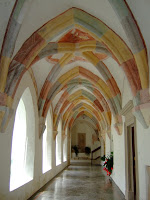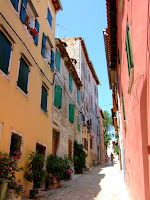 In contrast to the cold, miserable, wet weather we returned to last Monday, Saturday’s forecast was for a fabulous summer day, in fact the temperature rose over to 30 degrees.
In contrast to the cold, miserable, wet weather we returned to last Monday, Saturday’s forecast was for a fabulous summer day, in fact the temperature rose over to 30 degrees.We had accommodation booked at Huntingdon, so decided to hire a boat to cruise the River Great Ouse. We couldn’t believe it when we arrived at the boat yard in glorious sunshine to be told the river was in flood and closed to navigation. This was the second time we had visited this area hoping to hire a boat; the situation was identical first time around.
 Instead we explored, on foot, some of the towns that we had hoped to boat through.
Instead we explored, on foot, some of the towns that we had hoped to boat through.Huntingdon itself has a nice market square, but most interesting was the Cromwell Museum. Oliver Cromwell was born here, grew up and had his schooling in this town.
Downstream we re-visited Houghton Mill and ate our picnic lunch by river overlooking the mill, a great spot on a summer’s day.
Next stop was St Ives of “when I was going to St Ives” fame. This is very picturesque and the bridge, built in 1426 is one of four “Chapel” bridges surviving in Britain. The pilgrim chapel is at the centre pier.




Further downstream is Holywell: an ancient ring village. This lovely quiet town has a number of beautiful thatched cottages along the river. Because of the high water level, the road outside the thatched pub was under water.
 Enough driving, it was time for a walk. There are many circular walks along the length of the River Great Ouse. We chose a 4.5 mile walk taking in two towns and a stretch along the riverside, which fortunately was along a stop-bank as either side of us we could see extensive flooding.
Enough driving, it was time for a walk. There are many circular walks along the length of the River Great Ouse. We chose a 4.5 mile walk taking in two towns and a stretch along the riverside, which fortunately was along a stop-bank as either side of us we could see extensive flooding. Start and stop point was the small town of Bluntisham where they have a weather station recording temperature and barometric pressure. The graph was visible through the glass case and although the barometer seemed to be dipping slightly, the temperature was rising through 32 degrees.
Start and stop point was the small town of Bluntisham where they have a weather station recording temperature and barometric pressure. The graph was visible through the glass case and although the barometer seemed to be dipping slightly, the temperature was rising through 32 degrees. We finished the day with a picnic dessert at Godmanchester, another extremely charming riverside town.
We finished the day with a picnic dessert at Godmanchester, another extremely charming riverside town.

















































